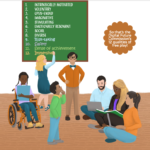For those of you who read the brief chickadee and the bird bath anecdote in a previous post, the chickadees never showed up. But a few days ago, a Steller’s jay braved landing on the small, hanging bird bath and took a big drink. She or he made a very unique two-part comment—not the usual call I hear them make. (He? She? After checking 3 of my mother’s bird books and the Cornell Lab of Ornithology website, I found nothing about how to tell the difference between a male and female…so I brought out the big guns…Birds of the Sierra Nevada—Their Natural History, Status, and Distribution by Edward C. Beedy and Edward R. Pandofino, illustrated by Keith Hansen (I bought my copy from Keith in his studio in Bolinas, California).
“Steller Jay males and females wear identical plumage and sport conspicuous crests with grayish-black heads and throats; the remainder of their plumage is a deep blue, and the wings and tail are especially vibrant.”
I am not a “birder.” My mother was so I know I’m not. But I did get some birding in my bones by osmosis. I know a sparrow from a wren. I can identify nuthatches and juncos. And I was ecstatic when I heard a sharp, piercing call and spotted a flicker in a treetop shortly after I moved to my current San Francisco Bay Area neighborhood. I hadn’t seen a flicker since my childhood in Ohio, decades ago.

I missed photographing the jay on the first sighting—s/he flew away before I could grab the camera, but s/he showed up again today—I heard that same funny call, grabbed my phone, quickly opened the camera app, and captured the moment in this (mindful digital) photo.
Investigation—Grow Your Sense of Place
I consider Investigation an essential practice for Mindful Digital Life. We build technology habits before we even notice. We fall into ruts—often we are pulled there by designers who understand our neurotransmitters better than we do ourselves. If you’d like some evidence for that, watch this April 2017 TED talk by Tristan Harris, the former design ethicist at Google and founder of Time Well Spent.
Numerous reports have shown that we’re spending less and less time in nature. A study released in October, 2016 by Isle of Man Tourism in the UK found that 80% of children in North East England could identify the Pikachu character from Pokemon while 60% could identify a sparrow, one of the most common birds. From the report: “Researchers also found out that more than a third (36%) of children in the North East they asked see nature more on TV or in video games than they do in real life.”
A large part of my work today is mediated through my laptop and big screen monitor. The view of the jay perched on the bath in the photo above is out my window from my desk (with the camera zoomed in).
This bird bath is one of my personal Investigations in growing my sense of place. It’s just one of many counterbalances to my digital life. By the simple act of pouring fresh water daily into a repurposed hanging planter, I’ve discovered that female and male Steller’s Jays are hard to tell apart, unlike many other birds I know (if any birders reading have some tips for me, do let me know), and that this jay announces when s/he lands on the bird bath with a two-part, distinctive call.
How are you currently modeling connection to nature where you live? What new investigations will you begin? What investigations are your kids already doing? What new investigations are they interested in doing? If you don’t know, ask them. I’d love to hear…just click reply to this email to let me know.
Go Deeper?
I have been reading the excellent Orion magazine for several years now. In the May/June 2017 issue, I stumbled upon this beautiful essay by nature writer Peter Friederici titled Stellar…give it a read and you’ll learn the how and why of spelling this stellar corvid’s odd name.
If you are interested in investigating how technology designers hijack your attention, watch this 2014 talk at TEDxBrussels by Tristan Harris. It’s very detailed with a range of social media examples and ideas about how technology could meet deeper human values and goals. This video is a great family conversation catalyst. Tristan asks really important questions.


